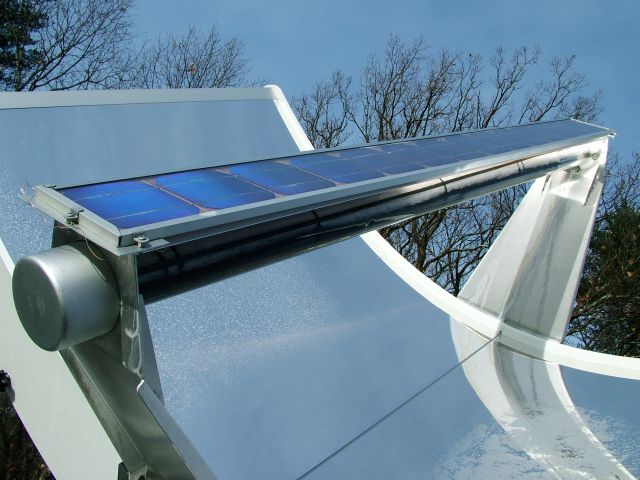| Concentrating Solar Hydrogen Generators
Generatori di Idrogeno a Concentrazione Solare combinato al Fotovoltaico
Nanoptek

 Un sistema che utilizza un particolare fotoanodo brevettato, in grado di dissociare l'acqua in idrogeno e ossigeno, usando 1 terzo dell'energia elettrica necessaria, associando la luce solare concentrata in un fattore di 30x  Technology downloadSHG300Photos.pdf Technology downloadSHG300Photos.pdf Questo PDF contiene diverse immagini del nostro SHG300 ™, incompleto in confronto con la nostra SHG50. VLTrev5.pdf Questo PDF contiene informazioni sui nostri foto-catalitico luce visibile ™ e ™ Sunblock avanzata. SHG300EESrev3.pdf Questo PDF si concentra sull'applicazione immagazzinamento dell'energia elettrica per i nostri SHG300 ™. SHG50GC.pdf Questo PDF è prodotto di letteratura per il nostro SHG50 ™. SHG300rev2.pdf Questo PDF è prodotto di letteratura per il nostro SHG300 ™. Nanoptek Corporation Rev1.ppt Questa è una panoramica della tecnologia di Nanoptek. Nanoptek Riflettore 3a.wmv Questa e' un'animazione, creata da C. Chamberlain, è un vecchio prototipo di concentrazione ed è inclusa qui solo per divertimento. Brevetti U.S. Patent No. 7,485,799
U.S. Patent No. 7,628,928
U.S. Patent No. 7,947,221
U.S. Patent No. 7,992,528
U.S. Patent No. 7,995,871
Nine (9) additional U.S. and International patents pending and/or applied for
Nine (9) licensed patents
Pubblicazioni:
Guerra, J. M., “Efficient Hybrid Solar Hydrogen Generator,”.pdf Cryogas International, Vol. 49, No. 2, pp. 42-44. February 2011
Lukas Thulin and John Guerra, “Calculations of strain-modified anatase TiO2 band structures,” Physical Review B 77, 195112 (2008)
J.M. Guerra, L. Thulin, D. Vezenov et al, “Embedded nano-optic media for near-field high density optical data storage: modeling, fabrication, and performance,” Proceedings, Optical Data Storage Conference, SPIE, April, 2001.
J. M. Guerra, L/ Thulin, D. Vezenov et al, “Near-field optical recording without low-flying heads,” ISOM Technical Digest, Taipei, 2001.
J. M. Guerra, L. Thulin, D. Vezenov et al, “Near-field optical recording without low-flying heads: Integral Near-Field Optical (INFO) Media,” Japanese Journal of Applied Physics, Vol. 41 (2002) pp. 1866-1875 Pt. 1, No. 3B, March, 2002.
Guerra, J. M., “Photon tunneling microscopy,” in Proceedings from Surface Measurement and Characterization Meeting, Hamburg, SPIE Vol. 1009, pp. 254-262, 1988.
Guerra, J. M., “Photon tunneling microscope,” Paper Summaries, SPSE 42nd Annual Conference, Boston, pp. 11-15, 1989.
Guerra, J. M., “Photon tunneling microscopy,” Applied Optics, Vol. 29, No. 26, pp. 3741-3752, 1990.
Guerra, J. M., “Photon tunneling microscopy of polymers,” IS&T 46th Annual Conference Advance Printing of Paper Summaries, Cambridge, Mass., pp. 62-66, 1993.
Guerra, J. M., “Photon tunneling microscopy of diamond-turned surfaces,” Applied Optics, Vol. 32, No.1, pp. 24-26, 1993.
Guerra, J. M., Srinivasarao, M., Winter, H. H., Stein, R. S., “Photon Tunneling Microscopy,” Polymer Preprints (April 1992), Vol. 33.
Guerra, J. M., Srinivasarao, M., and Stein, R., “Photon tunneling microscopy of polymeric surfaces,” Science, Vol. 262, pp. 1395-1400, 1993.
Guerra, J. M., Srinivasarao, M., and Winter, H., “Photon tunneling microscopy of single crystals of polypropylene,” Polymer, April, 1994.
Guerra, J. M., Hsieh, A., and Srinivasarao, M., “Photon tunneling microscopy of polymers,” AFM/STM Conference (1993), Natick Army Labs., Natick, Mass. In: Atomic Force Microscopy/ Scanning Tunneling Microscopy, Edited by S. Cohen, M. Bray, and M. Lightbody, Plenum Press, 1994.
Guerra, J. M., “Photon tunneling microscopy applications.” In: Materials Research Society Symposium Proceedings: Determining Nanoscale Physical Properties of Materials by Microscopy and Spectroscopy, Vol. 332: 449-460, M. Sarikaya, H. K. Wickramasinghe and M. Isaacson, eds. 1994.
Guerra, J. M., “Super-resolution through Diffraction-born Evanescent Waves,” Appl. Phys. Lett. 66 (26), p. 3555. 1995.
J. M. Guerra and G. K. Menon, “Photon Tunneling Microscopy: A New Technique for Imaging Stratum Corneum,” The Journal of Investigative Dermatology, To be published.
J. M. Bennett, Y. Namba, J. M. Guerra, J. Jahanmir, T. L. Balter, and J. C. Podlesny, “Topographic Measurements of Precision Ground Optical Glasses,” Applied Optics, Vol. 36, (10) p. 2211-2216, 1997.
K. Goyal, J. D. Bhawalker, Y. Conturie, P. Gavrilovic, Y. Mao, H. Po, and J. Guerra, “High beam quality of ultraviolet radiation generated through resonant enhanced frequency doubling of a diode laser,” J. Opt. Soc. Am. B, Vol. 16, No. 12, Dec. 1999. P. 2207-2216.
Guerra, J. M., Photon Tunneling Microscopy: Seeing in Forbidden Light, Kluwer Academic Publishers, Dordrecht (in preparation).
Lavori in cui si fa' riferimento:
Characterization of Optical Thin Films (D. Smith, Institute of Optics, 1991).
Collier’s Encyclopedia Yearbook of 1993 (P. F. Collier, 1994).
Atomic Force Microscopy/Scanning Tunneling Microscopy, (S. Cohen, M. Bray, and M. Lightbody, Eds., Plenum Press, 1994).
Determining Nanoscale Physical Properties of Materials by Microscopy and Spectroscopy, (M. Sarikaya, H. K. Wickramasinghe and M. Isaacson, Eds., Materials Research Society Symposium Proceedings, 1994).
Surface Analysis of Paper (T. Connors, S. Banerjee, Eds., CRC Press, 1995).
Near-Field Optics (M. A. Paesler and P. J. Moyer, Wiley Interscience, 1996).
Optical Methods in Surface Metrology (D. J. Whitehouse, S.P.I.E.’s Milestone Series of Selected Reprints, 1996: three papers selected).
Near Field Optics and Nanoscopy (J. P. Fillard, Scientific World Co., 1998).
Handbook of Physical Vapor Deposition (PVD) Processing (D. M. Mattox, Noyes Publications, 1998).
Near-Field Nano-Optics (M. Ohtsu and H. Hori, Kluwer Academic / Plenum Publishers, 1999).
Evanescent Waves from Newtonian Optics to Atomic Optics (F. deFornel, Springer, 2000).
Comprehensive Polymer Science, (second supplement, M. Srinivasarao, “Recent Advances in Microscopy,” Pergamon Press, in press).
Photonics for Fiber and Integrated Optics (K. Iizuka, Wiley, July, 2001).
Near Field Optics (S. Jutamulia, S.P.I.E.’s Milestone Series of Selected Reprints, 2001.
Near-Field Optics and Surface Plasmon Polaritons (S. Kawata, Ed., Topics in Applied Physics, Vol. 81, Springer, 2001).
Care of Astronomical Telescopes and Accessories (M. Barlow Pepin, Patrick Moore’s Practical Astronomy Series, Springer, 2004).
Multi-Modality Microscopy (H. Yu, P. Cheng, P. Lin, and F. Kao Eds., World Scientific, 2006). Edited by fabrizio3 - 20/10/2011, 16:24 |



